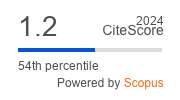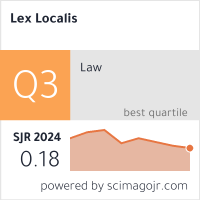The Assessment of Public Health Capacities at Local Self-governments in Serbia
DOI:
https://doi.org/10.4335/21.4.1201-1234(2023)Keywords:
public health, local self-government, capacity development, SerbiaAbstract
The objective of this quantitative study was to examine the impact of selected factors on the level and state of public health capacities in local self-government units in 2021. This survey included 77 out of 145 local self-government units in the Republic of Serbia and examined six dimensions defined by the Law on Public Health. The results of the Pearson correlation showed that there were statistically significant correlations between the effectiveness of the realized program budget and microbiologically defective drinking water samples from the so-called village water supply systems, defective samples of drinking water from public taps, unsatisfactory analyses of wastewater samples, and the number of mandated fines issued. The results of the logistic regression model showed that the local self-government units that received assistance from the Standing Conference of Towns and Municipalities were 5.6 times more likely to perform analyses of their health status.
References
Aluttis, C., den Broucke, S. V., Chiotan, C., Costongs, C., Michelsen, K. & Brand, H. (2014) Public health and health promotion capacity at national and regional level: a review of conceptual frameworks, Journal of public health research, 3(1), https://doi.org/10.4081/jphr.2014.199.
Al-ramlawi, A., El-Mougher, M. & Al-Agha, M. (2020) The Role of Al-Shifa Medical Complex Administration in Evacuation & Sheltering Planning, International Journal of Disaster Risk Management, 2(2), pp. 19-36.
Anugwom, E. E. (2020) Health promotion and its challenges to public health delivery system in Africa, In: Anugwom, E. E. & Awofeso, N. (eds.) Public Health in Developing Countries (Rijeka: IntechOpen), pp. 1-274, https://doi.org/10.5772/intechopen.91859.
Akter, R., Roy, T. & Aktar, R. (2023) The Challenges of Women in Post-disaster Health Management: A Study in Khulna District, International Journal of Disaster Risk Management, 5(1), pp. 51-66.
Arrieta, A., Woods, J. R., Qiao, N. & Jay, S. J. (2014) Cost–benefit analysis of home blood pressure monitoring in hypertension diagnosis and treatment: an insurer perspective, Hypertension, 64(4), pp. 891-896.
Baillie, E., Bjarnholt, C., Gruber, M. & Hughes, R. (2008) A capacity-building conceptual framework for public health nutrition practice, Public Health Nutrition, 12(08), pp. 1031-1038, https://doi.org/10.1017/s1368980008003078.
Bara, A. C., Van den Heuvel, W. J. & Maarse, J. A. (2002) Reforms of health care system in Romania, Croatian Medical Journal, 43(4), pp. 446-452.
Boulware, L. E., Cooper, L. A., Ratner, L. E., LaVeist, T. A. & Powe, N. R. (2003) Race and trust in the health care system, Public health reports, 118(4), https://doi.org/10.1093/phr/118.4.358.
Bradley, E. H., Canavan, M., Rogan, E., Talbert-Slagle, K., Ndumele, C., Taylor, L. & Curry, L. A. (2016) Variation in health outcomes: the role of spending on social services, public health, and health care, 2000–09, Health Affairs, 35(5), pp. 760-768.
Brownson, R. C., Fielding, J. E. & Maylahn, C. M. (2009) Evidence-based public health: a fundamental concept for public health practice, Annual review of public health, 30, pp. 175-201.
Brownson, R. C., Baker, E. A., Deshpande, A. D. & Gillespie, K. N. (2017) Evidence-Based Public Health (Oxford, UK: Oxford University Press).
Busse, R., Riesberg, A. & World Health, O. (2004) Health Care Systems in Transition (Berlin, Germany: SAGE Publications Inc.).
Cho, H. & Witte, K. (2005) Managing fear in public health campaigns: a theory-based formative evaluation process, Health promotion practice, 6(4), pp. 482-490.
Collins, S. R., Rasmussen, P. W., Doty, M. M. & Beutel, S. (2015) The rise in health care coverage and affordability since health reform took effect (New York, NY: The Commonwealth Fund).
Cvetković, V. M., Dragašević, A., Protić, D., Janković, B., Nikolić, N. & Milošević, P. (2022a) Fire safety behavior model for residential buildings: Implications for disaster risk reduction, International journal of disaster risk reduction, 76.
Cvetković, V. M., Öcal, A. & Ivanov, A. (2019) Young adults’ fear of disasters: A case study of residents from Turkey, Serbia and Macedonia, International Journal of Disaster Risk Reduction, 35.
Cvetković, V. M., Tanasić, J., Ocal, A., Kešetović, Ž., Nikolić, N. & Dragašević, A. (2021b) Capacity development of local self-governments for disaster risk management, International Journal of Environmental Research and Public Health, 18(19).
Doherty, T. M., Del Giudice, G. & Maggi, S. (2019) Adult vaccination as part of a healthy lifestyle: moving from medical intervention to health promotion, Annals of medicine, 51(2), pp. 128-140.
El-Mougher, M. M. (2022) Level of coordination between the humanitarian and governmental organizations in Gaza Strip and its impact on the humanitarian interventions to the Internally Displaced People (IDPs) following May escalation 2021, International Journal of Disaster Risk Management, 4(2), pp. 15-45.
Fielding, J. E. & Briss, P. A. (2006) Promoting evidence-based public health policy: can we have better evidence and more action?, Health affairs, 25(4), pp. 969-978.
France, G., Taroni, F. & Donatini, A. (2005) The Italian health‐care system, Health economics, 14(S1), pp. S187-S202.
Frank, D. A., Neault, N. B., Skalicky, A., Cook, J. T., Wilson, J. D., Levenson, S. & Berkowitz, C. (2006) Heat or eat: the Low Income Home Energy Assistance Program and nutritional and health risks among children less than 3 years of age, Pediatrics, 118(5), pp. e1293-e1302.
Gatseva, P. D. & Argirova, M. (2011) Public health: the science of promoting health, Journal of Public Health, 19, pp. 205-206.
Glanz, K. & Bishop, D. B. (2010) The role of behavioral science theory in development and implementation of public health interventions, Annual review of public health, 31, pp. 399-418.
Harms-Ringdahl, L. (2001) Safety Analysis: Principles and Practice in Occupational Safety (Boca Raton, FL, USA: CRC Press).
Hartley, D. M. & Perencevich, E. N. (2020) Public health interventions for COVID-19: emerging evidence and implications for an evolving public health crisis, Jama, 323(19), pp. 1908-1909.
Hawe, P., Noort, M., King, L. & Jordens, C. (1997) Multiplying health gains: the critical role of capacity-building within health promotion programs, Health policy, 39(1), pp. 29-42.
Herd, P., Schoeni, R. F. & House, J. S. (2008) Upstream solutions: does the supplemental security income program reduce disability in the elderly?, The Milbank Quarterly, 86(1), pp. 5-45.
Institute of Public Health of Serbia “Dr. Milan Jovanovic Batut” (IJZS) (WHO), available at: https://covid19.rs/ (December 9, 2021).
Institute of Statistics of the Republic of Serbia – ISRS (2021) Statistical yearbook (Belgrade, Serbia: Statistical Office of the Republic of Serbia), available at: https://www.stat.gov.rs/en-us/publikacije/publication/?p=13253 (July 5, 2023).
Jackson, N. & Waters, E. (2005) Criteria for the systematic review of health promotion and public health interventions, Health promotion international, 20(4), pp. 367-374.
Jagrič, T., Mun, J. C., Brown, C. E. & Fister, D. (2021) Economic Impact of the Health Sector on the Regional Level-Case of a Small, Open Economy, Lex Localis - Journal of Local Self-Government, 19(3), pp. 621-657, https://doi.org/10.4335/19.3.621-658(2021).
Kaur, B. (2020) Disasters and exemplified vulnerabilities in a cramped Public Health Infrastructure in India, International Journal of Disaster Risk Management, 2(1), pp. 15-22.
Kawachi, I. (2001) Social capital for health and human development, Development, 44, pp. 31-35.
Kickbusch, I. (2003) The contribution of the World Health Organization to a new public health and health promotion, American journal of public health, 93(3), pp. 383-388.
Kirmayer, L. J., Sehdev, M., Whitley, R., Dandeneau, S. F. & Isaac, C. (2009) Community resilience: Models, metaphors and measures, International Journal of Indigenous Health, 5(1), pp. 62-117.
Kuehl, K. S., Elliot, D. L., Goldberg, L., Moe, E. L., Perrier, E. & Smith, J. (2013) Economic benefit of the PHLAME wellness programme on firefighter injury, Occupational medicine, 63(3), pp. 203-209.
Kwangkee, K. & Moody, P. M. (1992) More resources better health? A cross-national perspective, Social science & medicine, 34(8), pp. 837-842.
Lewis, M. (2006) Governance and corruption in public health care systems, Center for Global Development Working Paper, no. 78.
Li, W., Yang, Y., Liu, Z. H., Zhao, Y. J., Zhang, Q., Zhang, L. & Xiang, Y. T. (2020) Progression of mental health services during the COVID-19 outbreak in China, International journal of biological sciences, 16(10).
Liu, Y. (2004) China's public health-care system: facing the challenges, Bulletin of the World Health Organization, 82(7), pp. 532-538.
Long, D. A. & Sheehan, P. (2010) A case study of population health improvement at a Midwest regional hospital employer, Population health management, 13(3), pp. 163-173.
Ludwig, J., Sanbonmatsu, L., Gennetian, L., Adam, E., Duncan, G. J., Katz, L. F. & McDade, T. W. (2011) Neighborhoods, obesity, and diabetes - a randomized social experiment, New England journal of medicine, 365(16), pp. 1509-1519.
MacLean, L., Edwards, N., Garrard, M., Sims-Jones, N., Clinton, K. & Ashley, L. (2009) Obesity, stigma and public health planning, Health promotion international, 24(1), pp. 88-93.
Masters, R., Anwar, E., Collins, B., Cookson, R. & Capewell, S. (2017) Return on investment of public health interventions: a systematic review, Journal of Epidemiology and Community Health, 71(8), pp. 827-834.
Mekonnen, M. M. & Hoekstra, A. Y. (2016) Four billion people facing severe water scarcity, Science advances, 2(2).
Mendivil, J., García-Altés, A., Pérez, K., Marí-Dell'Olmo, M. & Tobías, A. (2012) Speed cameras in an urban setting: a cost–benefit analysis, Injury prevention, 18(2), pp. 75-80.
Nutbeam, D. (2000) Health literacy as a public health goal: a challenge for contemporary health education and communication strategies into the 21st century, Health promotion international, 15(3), pp. 259-267.
Öcal, A., Cvetković, V. M., Baytiyeh, H., Tedim, F. M. S. & Zečević, M. (2020) Public reactions to the disaster COVID-19: a comparative study in Italy, Lebanon, Portugal, and Serbia. Geomatics, Natural Hazards and Risk, 11(1), pp. 1864-1885.
National Health Expenditure Accounts (NHEA) (2023) National Health Expenditure Data, available at: https://www.cms.gov/data-research/statistics-trends-and-reports/national-health-expenditure-data (September 7, 2023).
Reynolds, A. J., Temple, J. A., White, B. A., Ou, S. R. & Robertson, D. L. (2011) Age 26 cost–benefit analysis of the child‐parent center early education program, Child development, 82(1), pp. 379-404.
Rocha, N. P., Dias, A., Santinha, G., Rodrigues, M., Queirós, A. & Rodrigues, C. (2019) Smart cities and public health: a systematic review, Procedia computer science, 164, pp. 516-523.
Rosen, G. A. (2015) History of Public Health, revised expanded Hopkins, J. (ed.) (Baltimore, MD, USA: University Press).
Rozmarinova, J. (2019) Analysis of Regional Health Plans as Enactments of National Health Policy, Lex Localis-Journal of Local Self-Government, 17(3), pp. 659-677, https://doi.org/10.4335/17.3.659-677(2019).
Tabachnick, B. G., Fidell, L. S. & Ullman, J. B. (2007) Using Multivariate Statistics, vol. 5 (Boston, MA, USA: Pearson).
WHO Regional Office for Europe (2012) European action plan for strengthening public health capacities and services, available at: http://www.euro.who.int/__data/assets/pdf_file/0005/171770/RC62wd12rev1-Eng.pdf (March, 12 2022).
Wilkinson, R. & Pickett, K. (2010) The spirit level. Why equality is better for everyone (London: Penguin UK).
World Health Organization (2021) 21st century health challenges: can the essential public health functions make a difference? Report – High level review of configuration and reform of Public Health systems in selected countries, available at: https://apps.who.int/iris/bitstream/handle/10665/351510/9789240038929-eng.pdf?sequence=1&isAllowed=y (March 12, 2022).








